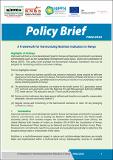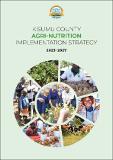Special Paper No. 11 of 2024 on Status of Food and Nutrition Security in Kenya: An Implementation of the Framework for Harmonizing Nutrition Indicators
Publication Date
2024Author
views
downloads
Metadata
Show full item recordBy
Gideon Nyakundi; Allan Gathuru; Samuel Kipruto; Isabella Kiplagat; Japheth Kathenge; Eunice Mulango; Damaris Mulwa; and Dorah Momanyi
Abstract/
Food security and nutrition is a major global concern and remains a policy priority in Kenya. The targets of Sustainable Development Goal 2 (SDG 2) directly address nutrition, focusing on the reduction of hunger and all forms of malnutrition such as stunting and wasting; increasing agricultural productivity; and ensuring sustainable food production systems. In Kenya, the Food Security Act (2017) and the Constitution of Kenya (2010) recognize food security and nutrition as a basic human right for every individual. The food security and nutritional status in Kenya is measured by a comprehensive Food Security and Nutrition Index. The Index is derived from an intricate analysis of food and nutrition indicators from multiple sectors including health, agriculture, water, social protection, and education, and offers valuable insights into the intricacies of food security challenges in Kenya. The overall average score on the Food Security and Nutrition Index was 0.44 – which indicates moderate food security and nutrition – with significant variations across different sectors. Health, water, and education sectors performed relatively better, whereas social protection, agriculture, and environmental management lagged. The average health sector index was 0.65. There was a significant improvement in certain areas in the sector, for example, iron/folic acid supplementation among women and the consumption of iron-rich foods. However, the low levels of vitamin A supplementation and exclusive breastfeeding rates highlight areas that need targeted interventions. The consumption of vitamin A-rich foods among children under five (5) years improved from 38 per cent in 2016 to 41 per cent in 2022.
Subject/
Food Security; Nutrition Index; Micronutrients Deficiency; Child Feeding; Food Poverty
Publisher
National Information Platform on Food and Nutrition (NIPFN)Series
SP/11/2024;Collections
- NIPFN [24]
Related items
Showing items related by title, author, creator and subject.
-
Nyandarua County Nutrition Action Plan 2023/2024-2027/2028
County Government of Nyandarua (County Government of Nyandarua, 2023)Nyandarua County Nutrition Action Plan 2023/2024-2027/2028 is a road map that seeks to address nutrition challenges in the county. It is a comprehensive plan that provides a coordinated implementation of nutrition interventions ... -
Policy Brief No. 02/2023 on a Framework for Harmonizing Nutrition Indicators in Kenya
National Information Platform for Food Security and Nutrition (National Information Platform for Food Security and Nutrition, 2023-04)The Policy Brief on a Framework for Harmonizing Nutrition Indicators in Kenya by the National Irrigation Programme Focus for Nutrition (NIFPN) presents a framework for harmonizing nutrition indicators across different ... -
Kisumu City County Agri-Nutrition Strategy Paper 2023-2027
County Government of Kisumu (County Government of Kisumu, 2023)The Kisumu County Agri-Nutrition Implementation Strategy (CANIS) has been developed at a time when the world, Kenya, and Kisumu are experiencing challenges to adequate, safe, and nutritious food for their populations. ...




